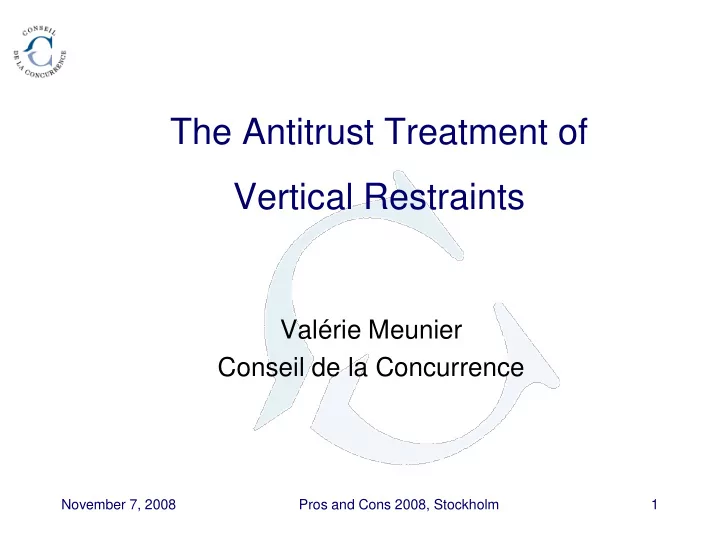

The Antitrust Treatment of Vertical Restraints Valérie Meunier Conseil de la Concurrence November 7, 2008 Pros and Cons 2008, Stockholm 1
Bayesian Decision Theory Prior belief based on empirical literature Bayesian updating based on evidence Decision minimizing loss function French laws regulating retailing sector minimum RPM Empirical studies on French data show prices have increased and become more uniform in retailing sector. Support for a negative presumption. November 7, 2008 Pros and Cons 2008, Stockholm 2
Empirical Literature on French Data Specificity of French regulation: • “General terms of sales” are observable; • Discrimination is prohibited; • Ban on below-cost pricing Below-cost threshold = invoiced price; Only rebates obtained at actual delivery can be subtracted from initial invoice • Planning regulations Retailers bargaining power High concentration in many catchment areas November 7, 2008 Pros and Cons 2008, Stockholm 3
Effects of Regulation on Prices Biscourp, Boutin, Vergé (2008) • Large data set (CPI) – Many items, many stores Correlation between market concentration and price level almost disappeared after introduction of regulation. Prices have increased, especially in stores where they were initially lower. November 7, 2008 Pros and Cons 2008, Stockholm 4
Structural model of vertical relationships Bonnet, Dubois (2008) • Data on bottled water, 1998-2000 7 retailers (70% market) 8 brands (71% of purchases) • Test between 12 alternative models Best fit: Two-part tariffs with RPM Retailers variable margin = 0 Fixed transfers from M to R (“Backward margins”) Two-part tariffs without RPM would have increased consumer surplus by 0.8%. November 7, 2008 Pros and Cons 2008, Stockholm 5
School calculators (03-D-45, Sept. 25, 2003) Theory of harm: Manufacturers’ cartel 2 Manufacturers (TI, Casio), many retailers Calculators for junior & senior high school students Teachers are prescribers RPM: • mails with resale prices • Price monitoring: Suppliers called deviating retailers to order • Evidence of significant application; Uniformity of prices across retailers. November 7, 2008 Pros and Cons 2008, Stockholm 6
School Calculators (cont’d) Information exchange between the two suppliers Defendants did not provide evidence/arguments in favor of RPM (services, inventory,…) Two facilitating practices: RPM, information exchange Vertical price fixing agreements + horizontal manufacturers agreement Observed effects: prices of calculators increased, while prices of other electronic devices (PDAs) decreased. November 7, 2008 Pros and Cons 2008, Stockholm 7
Toys (07-D-50, Dec. 20, 2007) Network of vertical agreements “Regulation - induced” RPM: • All but one manufacturers set high wholesale prices • Retailers set retail price = below-cost threshold • No retail variable margins but fixed transfers from manufacturers to retailers • Below-cost threshold: credible commitment to high wholesale price, no upstream market power needed • One manufacturer did leave retail margins; Less success in sustaining high prices November 7, 2008 Pros and Cons 2008, Stockholm 8
Toys (cont’d) Underlying theory of harm: Strategic manipulation of regulation; Antitrust liability? Enforcement of agreement: • Retailers’ active monitoring; Price -beating guarantees; • Retailers informed manufacturers about price deviations and demanded appropriate action ; Manufacturers as common agents: no market power but commitment power thanks to regulation; Retailers have effective and credible threat: they can delist products for which undercutting occurred. November 7, 2008 Pros and Cons 2008, Stockholm 9
Leegin “Screening Factors” Share of industry’s output covered by RPM Source of the restraint • Greater suspicion if imposed by retailers Monitoring activity is easier to observe; Maybe more relevant? Entities with market power Bargaining power may be more relevant? November 7, 2008 Pros and Cons 2008, Stockholm 10
Recommend
More recommend